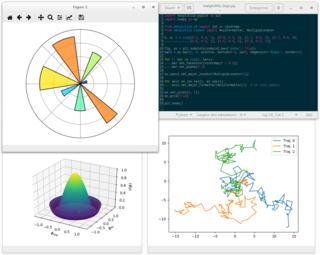Related Research Articles

MATLAB is a proprietary multi-paradigm programming language and numeric computing environment developed by MathWorks. MATLAB allows matrix manipulations, plotting of functions and data, implementation of algorithms, creation of user interfaces, and interfacing with programs written in other languages.

GNU Octave is a scientific programming language for scientific computing and numerical computation. Octave helps in solving linear and nonlinear problems numerically, and for performing other numerical experiments using a language that is mostly compatible with MATLAB. It may also be used as a batch-oriented language. As part of the GNU Project, it is free software under the terms of the GNU General Public License.

In computing, ls is a command to list computer files and directories in Unix and Unix-like operating systems. It is specified by POSIX and the Single UNIX Specification.

In computing, dir (directory) is a command in various computer operating systems used for computer file and directory listing. It is one of the basic commands to help navigate the file system. The command is usually implemented as an internal command in the command-line interpreter (shell). On some systems, a more graphical representation of the directory structure can be displayed using the tree command.
In computing, a clone is hardware or software that is designed to function in exactly the same way as another system. A specific subset of clones are remakes, which are revivals of old, obsolete, or discontinued products.
In computer science, array programming refers to solutions that allow the application of operations to an entire set of values at once. Such solutions are commonly used in scientific and engineering settings.

gretl is an open-source statistical package, mainly for econometrics. The name is an acronym for GnuRegression, Econometrics and Time-seriesLibrary.
The General Data Format for Biomedical Signals is a scientific and medical data file format. The aim of GDF is to combine and integrate the best features of all biosignal file formats into a single file format.

Matplotlib is a plotting library for the Python programming language and its numerical mathematics extension NumPy. It provides an object-oriented API for embedding plots into applications using general-purpose GUI toolkits like Tkinter, wxPython, Qt, or GTK. There is also a procedural "pylab" interface based on a state machine, designed to closely resemble that of MATLAB, though its use is discouraged. SciPy makes use of Matplotlib.

FreeMat is a free open-source numerical computing environment and programming language, similar to MATLAB and GNU Octave. In addition to supporting many MATLAB functions and some IDL functionality, it features a codeless interface to external C, C++, and Fortran code, further parallel distributed algorithm development, and has plotting and 3D visualization capabilities. Community support takes place in moderated Google Groups.
The following tables provide a comparison of numerical analysis software.
MPSolve is a package for the approximation of the roots of a univariate polynomial. It uses the Aberth method, combined with a careful use of multiprecision.
CGNS stands for CFD General Notation System. It is a general, portable, and extensible standard for the storage and retrieval of CFD analysis data. It consists of a collection of conventions, and free and open software implementing those conventions. It is self-descriptive, cross-platform also termed platform or machine independent, documented, and administered by an international steering committee. It is also an American Institute of Aeronautics and Astronautics (AIAA) recommended practice. The CGNS project originated in 1994 as a joint effort between Boeing and NASA, and has since grown to include many other contributing organizations worldwide. In 1999, control of CGNS was completely transferred to a public forum known as the CGNS Steering CommitteeArchived 2007-06-24 at the Wayback Machine. This Committee is made up of international representatives from government and private industry.
The Grid Analysis and Display System (GrADS) is an interactive desktop tool that is used for easy access, manipulation, and visualization of earth science data. The format of the data may be either binary, GRIB, NetCDF, or HDF-SDS. GrADS has been implemented worldwide on a variety of commonly used operating systems and is freely distributed over the Internet.
Chronux is an open-source software package developed for the loading, visualization and analysis of a variety of modalities / formats of neurobiological time series data. Usage of this tool enables neuroscientists to perform a variety of analysis on multichannel electrophysiological data such as LFP, EEG, MEG, Neuronal spike times and also on spatiotemporal data such as FMRI and dynamic optical imaging data. The software consists of a set of MATLAB routines interfaced with C libraries that can be used to perform the tasks that constitute a typical study of neurobiological data. These include local regression and smoothing, spike sorting and spectral analysis - including multitaper spectral analysis, a powerful nonparametric method to estimate power spectrum. The package also includes some GUIs for time series visualization and analysis. Chronux is GNU GPL v2 licensed.
ARPACK, the ARnoldi PACKage, is a numerical software library written in FORTRAN 77 for solving large scale eigenvalue problems in the matrix-free fashion.
Fast Artificial Neural Network (FANN) is cross-platform programming library for developing multilayer feedforward artificial neural networks (ANNs). It is free and open-source software licensed under the GNU Lesser General Public License (LGPL).